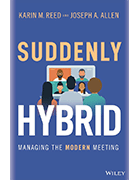Effective hybrid meetings require training, equity, best practices
Authors Karin M. Reed and Joseph A. Allen discuss the need for proper training and best practices to support inclusive and effective hybrid meetings.
Many organizations are now focused on hybrid work as they plan their post-pandemic workplaces. In a hybrid workforce, meetings are still the cornerstone of collaboration. But organizations can't expect teams to run hybrid meetings the same way they conduct virtual meetings.
In the book Suddenly Hybrid: Managing the Modern Meeting, authors Karin M. Reed and Joseph A. Allen examine the move from virtual to hybrid meetings, best practices for meeting leaders and attendees, and tips to support effective hybrid meetings.
Here, Reed and Allen discuss the challenges of hybrid meetings, why training is still needed and the importance of equity in hybrid meetings.
Editor's note: This interview has been edited for length and clarity.
What are the main challenges organizations face in supporting effective hybrid meetings?
Joseph A. Allen: Organizations are realizing: 'We actually have to do this.' And, when they realize that, they seek out technology to help with it. However, that's where some of the main pain points happen. Just buying a wonderful new technology and putting it in a room is only the first step.
 Joseph A. Allen
Joseph A. Allen
If you don't also teach people how to turn it on, some people are going to be like: 'Oh, I'll just push all the buttons until it starts working.' But that might be 10 minutes into the meeting before it actually starts working.
Once you get the hybrid meetings to happen, now, you've got a skills gap. The people who think they know how to run and facilitate this complex communication environment are realizing: 'Oh, this is a little harder than I thought because now I've got people who are audio, video and in person. I've got to make sure everybody gets a chance to say something.' And that can get really difficult.
 Karin M. Reed
Karin M. Reed
Karin M. Reed: We like to say you need the right hardware, software and skillware. The hardware meaning the equipment you have in the meeting room and the equipment the remote attendees have. Software meaning the right meeting platform that allows everybody to connect. The skill means the training to help people understand how to use the technology but, even more importantly, how to approach facilitating a meeting and being an attendee in a meeting where not everybody is in the same place.
Do you think with nearly all meetings being virtual in the last two years that organizations assume training isn't needed for hybrid meetings?
Reed: I'm definitely hearing that. I've heard some people on the user end who are getting frustrated by their IT departments because they say, 'We've been doing this for the past two years. What more do you need?' But it requires a completely different approach.
Whenever you have people in person and people who are remote -- and everybody has to talk to each other and have meeting equity and participation equity -- that requires some intentionality that is often not there.
Allen: Everyone's connected the same way in a face-to-face meeting. Everyone's connected the same way in a virtual meeting. When you step from that and put those two together, you have people connecting in different ways. Now, the number of different connection paths and the richness -- or the lack thereof -- of the fidelity of seeing versus not seeing the person, that makes a huge difference in how we communicate with people. That complex communication environment is not a one-to-one thing, and that's why it takes so much more effort.
We thought, when we first did the data collection for Suddenly Hybrid, we would see teams that were really struggling with this. But what we found was the teams that participated in the survey were actually the ones who were doing all the best practices we were recommending, and they were seeing real, awesome success with hybrid meetings.
But the vast majority of teams are not doing all those best practices, so they're running into these barriers, this complex communication environment, these headaches with the technology. If you think you can just hop in and do it, you're going to be mistaken.
How do you recommend individual employees and organizations communicate their expectations for what a successful hybrid meeting is?
Reed: It should be a conversation between facilities, IT and the end users. It should not be a decision that is made in a vacuum by the folks who are purchasing the technology because there are simple things that can make a big difference.
For example, I was working with a client where they outfitted all their rooms to be video-enabled. But they put the camera way at the top of the wall, so it's looking down on everybody. It would have made a huge difference if they put that camera at eye level of those who were seated around the table.
There are subtle differences that can be made in meeting design that makes sense from a communication best practice standpoint. But, often, the people who need to be in the room to address that aren't there, and the decisions are made in a technology bubble.
Allen: Then, you'd have the team-by-team-level conversations. We talk a lot about expectations in our book about how you need to set ground rules of how you're going to collaborate and communicate because getting into the conversation queue is different when you're in person versus on chat or on video.
Maybe you're using the chat function if you're on video. But how does a person who's on video get into the queue when in person? You might lean in or wave your hand at somebody. It doesn't quite work the same. You have to set a rule or expectations about how to get into the conversation; otherwise, you're going to create an artificial barrier to collaboration. You'll create a two-tiered system of those who are in the room and those who are not.
How should organizations examine what they're missing in terms of equity and how to approach equity in hybrid meetings?
Allen: Before COVID, people would limit the issues of sexism and racism as they played out within meetings, and this led to inequities that we are all very aware of. And what was fascinating for me was, when we first started collecting data once COVID hit, that equality and talk time emerged. Previously, there was no equality and talk time. Women didn't talk as much as the white man in the room -- and people of color were even less.
And, once COVID hit, we actually found parity. We found it was governed more by the number of cameras than it was by who was in the camera. The fascinating thing now, though, is hybrid is actually the most inclusive form of meeting because it allows people to meet from anywhere.
But, just as with face to face and virtual, over time, we have to be very careful of those biases entering in and making it so there's not equal participation or equal contribution. If you aren't allowing for equity, you're basically saying the really good ideas other people might have are not important.
That's the fascinating thing about hybrid is that potential to do exactly that: to provide those equal communication opportunities for anyone, no matter how they're connected to the meeting. That's what a lot of our best practices in the book are geared toward.
Reed: You always have to be fighting against a proximity bias. There are certain strategies that you can employ to help you guard against that. One of the things we've seen work time and again is effective hybrid organizations have a policy where remote [attendees] speak first.
For example, if you are kicking off a discussion and you're leading the meeting from within the physical meeting room, rather than turning to your right and saying: 'Hey, Joe, what do you think about this?' You turn your attention to the screen and ask a remote attendee to weigh in.
Not only does it give them an opportunity to have their voice heard, but it also raises the collective awareness of all in the meeting room. It's not just the people that you can reach out and touch. Things like that can make a big difference in allowing for better meeting equity.
Another thing to keep in mind is always push toward a remote perspective. One of the things we encourage leaders to do is to rotate how they lead a meeting. Sometimes, lead it from within the physical conference room, but then, sometimes, lead it from a remote position. That will remind you what it's like to attend a meeting remotely, and it will send a strong signal to your team that it doesn't matter where you're located. What matters is what you have to contribute in terms of ideas, opinions and insights.









